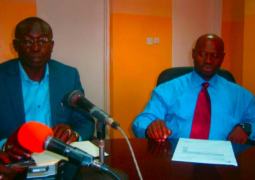Despite having received extensive debt relief, The Gambia continues to face a heavy debt burden, especially because of rising domestic debt, the International Monetary Fund, IMF, said Thursday.
In a statement issued after a press conference held yesterday at UN House in Cape Point, presided over by Meshack Tunee, IMF resident representative, the IMF said as at end-2010, domestic debt had risen to almost 30 percent of GDP with interest on domestic debt consuming an increasing share of government revenues (18 percent of government revenues in 2011).
“Despite a large reduction in its external debt under the Highly Indebted Poor Countries (HIPC) Initiative and Multilateral Debt Relief Initiative (MDRI) in December 2007, external debt indicators suggest that The Gambia is still at high risk of debt distress,” the statement said.
It however noted that the Gambian economy achieved robust growth with low-to-moderate inflation in recent years, despite the global economic crisis.
Below we reproduce excerpts from the IMF statement:
Real GDP growth averaged around 6½ percent a year during 2008-10, driven mainly by agriculture. Tourism and remittances, however, were hit hard by the global crisis. Meanwhile, inflation ranged between 2½ and 7 percent (year-on-year), as the Central Bank of The Gambia (CBG) generally maintained a restrained monetary stance. At times, this required extensive mopping up of liquidity generated by central bank financing of fiscal deficits.
The banking sector expanded at a rapid pace in recent years. Between 2007 and 2010, the number of banks doubled (to 14), helping to fuel a deepening of financial intermediation. During this period, credit to the private sector and public enterprises relative to GDP grew by about 4½ percentage points, to nearly 17½ percent of GDP. The new banks generated substantial foreign direct investment. The expansion in the banking sector, however, strained the CBG’s supervisory capacity, while intense competition among a high number of banks in a relatively small market contributed to increased risks to the banking system.
Progress on reducing poverty has been mixed. The government’s recent initiative to provide greater support to agriculture is expected to have contributed to reducing the incidence of poverty, as most of the poor live in rural areas. The Programme for Accelerated Growth and Employment (PAGE) is also expected to promote inclusive growth as it places emphasis on agriculture, as well as investment in infrastructure.
ECONOMIC DEVELOPMENTS IN 2011: MAINTAINING GROWTH, WHILE RESTORING FISCAL DISCIPLINE
The Gambian economy has continued to perform well in 2011, but vulnerabilities persist. In particular, poor weather conditions have weakened the expected expansion in agriculture. Still, real GDP is expected to grow by about 5½ percent partly due to early indications of an upturn in tourism. Year-on-year inflation stood at 4.4 percent in December 2011.
The Gambian authorities have made significant progress restoring fiscal discipline in 2011. By employing a strict cash budgeting approach to limit spending to available resources, government’s net domestic borrowing (NDB) was contained at just over 2½ percent of GDP in 2011. At the same time, the government has refrained from central bank financing of the deficit. The improved fiscal discipline has contributed to a drop in T-bill yields in recent months.
However, the authorities have yet to stop the steady erosion of government revenues (relative to GDP). Lost revenues from fuel taxes, mainly because of the failure to fully implement the new fuel pricing formula, accounted for most of the revenue shortfall in 2011. Poor tax compliance and falling duties on non-fuel imports also contributed to the poor revenue effort.
ECONOMIC OUTLOOK: BRIGHT, BUT WITH RISKS
Prospects for the Gambian economy over the near-and-medium term are good. Under the baseline scenario (not reflecting the PAGE), real GDP growth is projected to continue to grow at a robust pace (5½ percent a year), led by agriculture, a gradual, but sustained recovery in tourism and construction, and telecommunications. This outlook is predicated on a gradual fiscal adjustment to reduce the burden and risks of domestic debt.
The fiscal adjustment would ensure the CBG’s independence to focus on maintaining annual inflation around its objective of 5 percent, while also easing pressure on interest rates and avoiding crowding out of the private sector. The external current account deficit is expected to narrow to about 13 percent of GDP by 2016, financed primarily by FDI, project grants, and concessional loans. However, as the authorities seek to maintain the coverage of gross international reserves at around 5 months of imports, a financing gap would arise.
This scenario is subject to some risks. First and foremost, fiscal shocks—such as unanticipated revenue shortfalls and higher-than-budgeted spending—could threaten macroeconomic stability. The Gambian economy is also vulnerable to terms of trade and weather-related shocks.
A weaker global economy poses a near-term risk to growth, particularly for the tourism sector, but this risk would likely be mitigated by lower international prices for fuels and other imported commodities.
Policy Discussions: Sustaining Robust Growth and Poverty Reduction
Discussions focused primarily on two key challenges: (i) fiscal adjustment to reduce the burden and risks of domestic debt; and (ii) financing options for the PAGE. Discussions also covered other surveillance issues.
Although there were some differences, the authorities and IMF staff broadly agreed on the policy framework going forward. In particular, noting the high cost and roll-over risks of domestic debt, it was agreed that curbing government’s domestic borrowing should be the anchor for macroeconomic policies over the medium term.
Fiscal Adjustment: Near-term discipline and medium-term reforms
The authorities have chosen to pursue a gradual fiscal adjustment, aiming to reduce NDB to about ½ percent of GDP a year in 2014 and beyond. This adjustment can be viewed as a two-stage process: first, exercising discipline to achieve near-term targets for NDB; and second, a broader reform agenda encompassing tax policy, revenue administration, and public financial management (PFM).
In the near-term, IMF Staff advised the authorities to main fiscal discipline: To reap the benefits of a gradual fiscal adjustment—notably an easing of pressure on inflation and T-bill yields—as early as possible, it is necessary to build credibility in the authorities’ commitment to the adjustment path.
On the revenue side, staff recommended near-term measures to reverse the drop in revenues that occurred in 2011, including an immediate adjustment of fuel prices.
The authorities’ views: The authorities were concerned about the lack of donor support for the elections, but were confident that they could reallocate resources if needed. Similarly, they believed that claims of contingent liabilities and extra-budgetary spending could be contained. Although spending on many budgeted items has been trimmed, the authorities reiterated that they strive to meet key targets for poverty reducing expenditures, such as the 20 percent share of total current expenditures going toward basic and primary education.
To improve tax compliance, the government set up a Committee of Enquiry on Tax Evasion. At the same time, the Gambia Revenue Authority (GRA) has stepped up implementation of administrative measures in line with recommendations by Fund technical assistance.
Medium-term fiscal adjustment to support long-term growth
In addition to permanently reducing the high costs and rollover risk of the government’s domestic debt, the medium-term fiscal adjustment could incorporate reforms for tax policy, revenue administration, and public financial management that would enhance the effectiveness of government and The Gambia’s international competitiveness.
Monetary Policy and Financial Sector Stability
The remarkable progress in recent months toward eliminating fiscal dominance and effectively strengthening the independence of the CBG provides an opportunity to vastly improve the conduct of monetary policy.
Banks are generally well capitalized and liquid, although system-wide averages can mask potential problems in individual banks. With 13 banks competing for a small customer base, profitability has shrunk and NPLs have increased. Fund technical assistance is helping the CBG expand its toolkit for banking supervision with stress-testing capability.
Read Other Articles In Article (Archive)




